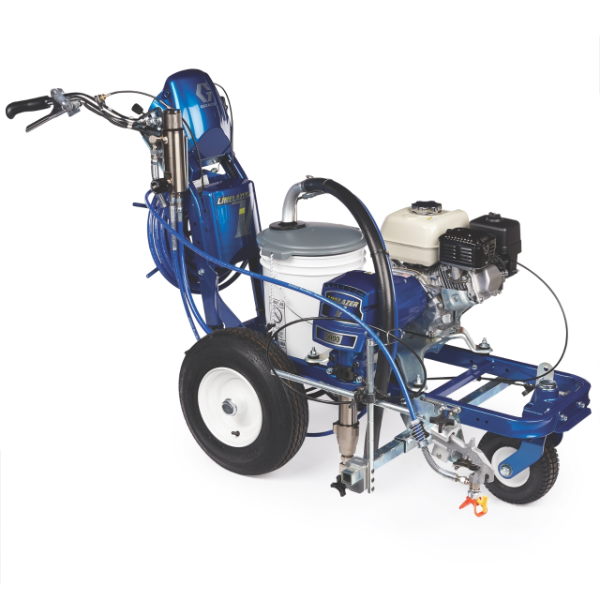Should airports invest in their own line marking equipment?
For an airport, investing in proper line marking equipment can bring advantages and save time and money.
As airports consider investing in line marking equipment, they should bear in mind its specific purpose. Easy-to-operate units can be managed by internal maintenance teams for everyday line marking or urgent touch-ups. Consider the time and money you could save.
Dedicated equipment for airport line marking comes in all shapes and sizes. The vast range of machinery and accessories on the market offers countless features, unique benefits and diverse applications. This raises questions for most airport maintenance departments. Should I invest in proper equipment? Should I (partially) outsource line marking or let my own maintenance team do the job? Explore some of the elements to be taken into consideration.
Balancing autonomy and dependence
Top-quality professional equipment is available for all kinds of line marking challenges. Carefully consider what tool fits your needs. Some line marking units are suitable for most airport areas, others are more useful for a specific line marking job. Deciding to invest in proper equipment also requires looking at the staffing you need to operate it. You need in-house staff to handle the job, but bear in mind that diversifying is an option. While some line marking jobs could be outsourced, others might be better managed in-house.
The benefits in-house line marking can bring
- Lower response times in case of emergency
It might pay to reorganise internal maintenance teams and train them for urgent line marking interventions involving damage or emergencies. Some of your internal teams are ‘on duty’ around the clock. Using their quieter moments might save you considerable time and money.
- Easier planning of non-urgent maintenance
Having proper equipment – even for larger or less urgent jobs – puts you in full control of your own planning.
- Cost-efficient
Choosing durable low-maintenance equipment with solid warranties will save you money, as you only need to invest once.
- Less red tape
Looking for contractors, preparing and evaluating RFPs, monitoring external parties and organising their access on site, often in secured areas, takes a lot of time and effort. Investing in your own equipment and using existing maintenance staff might be easier and more efficient.
- No unwanted contractor unavailability
When the weather is good, contractors are often busy, which leads to long waiting times, higher prices and possible operational interruption and safety breaches.
A tool for every line marking challenge
The market of line marking equipment is enormous. And there is no ideal one-size-fits-all machine that serves all line marking needs fully. A lot of machines are relatively universal, others are more suited to specific applications. For example, a compact electric line marking unit is perfect for indoor parking and storage areas, while large units that can be mounted on vehicles or combined with driver units can work long hours on runways and other heavy-use areas.
Before you decide what kind of line marking unit you need, consider:
- What area of your airport you are looking at (e.g. inside/outside, line marking for runways, taxiways and roads, car parks, boarding areas).
- The nature of the line marking in these places (e.g. colours, quality, patterns, symbols, specific composition of paint/texture such as beads).
- Quantity. Do you need to mark large surfaces at once, or smaller touch-ups?
- Wear/usage. Are these heavy-duty areas that suffer from wear easily?
- Investment/cost. Do the maths on what a specific external line marking job costs, including the time and risks involved in working with external parties.
Take your considerations and wish list to a line marking equipment specialist to learn what tools are best for your situation.
Investing in robust line marking equipment is worth considering
Acquiring your own line marking equipment implies you have the staff to operate it. That might not be as difficult as it seems. Maybe you can reorganise the schedule of existing maintenance teams to create extra in-house capacity. Also bear in mind that partial outsourcing is a possibility, for specific areas or specific levels of urgency, or for smaller versus larger jobs. Make an informed decision about what equipment serves your needs best. Choose robust and durable units that are low-maintenance and easy to operate and come with sufficient training.
Related Articles
Discover 5 challenges airports face when line marking
Line marking an airport properly enhances compliance, safety and smooth operations. Read the five challenges airports face in keeping all areas in good shape.
How to select the right airport line marking unit
Define what features matter for you when buying an airport line marking unit. Choose what kind of unit makes line marking easier and better quality.
What Graco airport line marking unit fits your needs?
Need outdoor or indoor line marking at your airport? Graco has electric, hydraulic and mechanical line marking units, fit for a multitude of applications.






